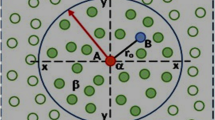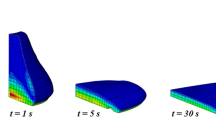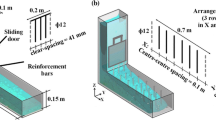Abstract
Numerical simulation of self-compacting concrete (SCC) flow shows great potential for developing into a powerful tool for prediction of SCC form filling. Numerical simulation is also of interest for modelling small scale material phenomena. This paper presents three different applications useful for modelling different phenomena on different scales: (i) particles, each representing an aggregate in the concrete, (ii) fluid, modelling concrete as a homogeneous liquid and (iii) particle in fluid, studying details of flow. The methods are compared and evaluated in order to give the reader a quick guidance into the world of possibilities that open up with numerical simulation.








Similar content being viewed by others
References
Tanigawa Y, Mori H (1986) Rheological analysis of slumping behavior of fresh concrete. In: Proceedings of the 29th Japan congress on materials research, Japan, p 129
Tanigawa Y, Mori H (1989) Analytical study on deformation of fresh concrete. J Eng Mech 115:493–508
Odaka S, Tanigawa Y, Mori H, Kurokawa Y (1993) Flow simulation of fresh concrete by dynamic viscosplastic suspensions element method. Trans Jpn Concr Ins15:39–46
Noor UA, Uomoto T (1999) Three-dimensional discrete element method of rheology tests of self-compacting concrete. In: Proceedings of the first international RILEM symposium on self-compacting concrete, Stockholm, Sweden
Puri U, Uomoto T (1999) Numerical modeling—a new tool for understanding shotcrete. Mater Struct 32:266–272
Chu H, Machida A (1998) Experimental evaluation and theoretical simulation of self-compacting concrete by the modified distinct element method (mdem). In: Recent advances in concrete technology, fourth CANMET/ACI/JCI international conference, Tokushima, Japan
Petersson O, Hakami H (2001) Simulation of self-compacting concrete—laboratory experiments and numerical modelling of testing methods, slump flow, j-ring and l-box tests. In: 2nd international SCC conference, Tokyo, Japan
Petersson O (2003) Simulation of self-compacting concrete—laboratory experiments and numerical modelling of testing methods, j-ring and l-box tests. In: Proceedings, 3rd international RILEM symposium, Reykjavik, Iceland, 2003, pp 202–207
Martys N, Ferraris CF (2002) Simulation of scc flow. In: Proceedings of the first north American conference on the design and use of self-consolidating concrete, Chicago, USA
Martys N, Personal communication, 18th ACBM/NIST computer modeling workshop
Hattori K, Izumi K (1990) A new viscosity equation for non-newtonian suspensions an its application. In: Rheology of fresh cement and concrete, proceedings of the international conference organized by The British society of rheology, University of Liverpool, March 16–29
Wallevik J (2003) Rheology of particle suspensions. Ph.D. thesis, NTNU, Trondheim, Norway
Thrane Nyholm L (2007) Form filling with self-compacting concrete, Ph.D. thesis, Danish Technological Institute
Modigell M, Vasilic K, Brameshuber W, Uebachs S (2006) Modelling and simulation of the flow behaviour of self-compacting concrete. In: Proceedings, 5th international RILEM symposium, Ghent, Belgium
Shyshko S, Mechtcherine V (2006) Continuous numerical modelling of concrete from fresh to hardened state. In: IBAUSIL, internationale Baustofftagung Weimar, Germany, 20–23 September
Dufour F, Pijaudier-Cabot G (2005) Numerical modelling of concrete flow: homogeneous approach. Int J Numer Anal Methods Geomech 29:395–416
Roussel N, Geiker MR, Dufour F, Thrane L, Szabo P (2007) Computational modeling of concrete flow: general overview. Cement Concr Res 37:1298–1307
Jeffrey G (1922) Proceedings of the rheological society, vol 102. pp 161–179
Laure P, Silva L, Coupez T, Toussaint F (2007) Numerical modelling of concrete flow with rigid fibers. In: ESAFORM conference on material forming, Zaragosa, Spain
Kokado T, Hosoda T, Miyagawa T, Fuji M (1997) Study on a method of obtaining yield values of fresh concrete from slump flow test. JSCE 37:29–42
Kokado T, Hosoda T, Miyagawa T (2000) Methods for evaluating rheological coefficients of self-compacting concrete by numerical analysis. JSCE 47:51–70
Roussel N, Coussot P (2005) “Fifity-cent rheometer” for yield stress measurements: from slump to spreading flow. J Rheol 49:705–718
Roussel N (2007) The lcpc box, a cheap and simple technique for yield stress measurements of SCC. Mater Struct 40:889–896
Barrat J-L, de Pablo J (2007) Modeling deformation and flow of disordered materials. MRS Bull 32:941–944
NTLHCP Roussel N (2007) General probabilistic approach to the filtration process. Phys Rev Lett 98:114502–1–4
Billberg P (1999) Self-compacting concrete for civil engineering structures—the swedish experience, Tech. Rep. 2:99, Swedish Cement and Concrete Research Institute, SE-100 44, Stockholm, Sweden
Macosko C (1994) Rheology principles, measurements and applications. CVCH Publishers, Inc., NY, USA
Cundall P, Strack O (1979) A discrete numerical model for granular assemblies. Geotechnique 29:47–65
Gram A, Farhang A, Silfwerbrand J (2007) Computer-aided modelling and simulation of self-compacting concrete flow. In: Proceedings, 5th international RILEM symposium, Ghent, Belgium, 2007, pp 455–460
Wendt J (ed) Computational fluid dynamics: an introduction. Springer, NY
Weller H, Tabor G, Jasak H, Fureby C (1998) A tensorial approach to computational continuum mechanics using object oriented techniques. Comput Phys 12:620–631
Hirt C, Nichols B (1981) Volume of fluid (VOF) method for the dynamics of free boundaries. J Comput Phys 39:201–225
Goldstein R (ed) (1996) Fluid mechanics measurements. Taylor and Francis, Washington, DC
Cook RD, Malkus DS, Plesha ME (1989) Concepts and applications of finite element analysis. John Wiley and Sons, Inc., New Jersey, USA
Amberg G, Tonhardt R, Winkler C (1999) Finite element simulations using symbolic computing. Math Comput Simul 49:257–274
Tezduyar T, Mittal S, Ray S, Shih R (1992) Incompressible flow computation with stabilized bilinear and linear equal-order interpolation velocity pressure element. Comput Methods Appl Mech Eng 95:221–242
Kundu P, Cohen I (2004) Fluid mechanics. Elsevier, New York, NY
JH. SS. Saak, AW (2001) New methodology for designing self-compacting concrete. ACI Mater J 98(6):429–439
Roussel N (2006) A theoretical frame to study stability of fresh concrete. Mater Struct 39(1):81–91
Vasilic K (2009) Computational modelling of SCC flow: reinforcement network modelled as porous medium. In: 3rd RILEM international symposium on rheology of cement suspensions such as fresh concrete. Rilem Publications, France
Gram A (2009) Modelling of self-compacting concrete flow-discrete and continuous approach (2009) Lic. thesis, Royal Institute of Technology, Sweden
Acknowledgements
Financial support from the Swedish Consortium on Financing Basic Research in the Concrete Field and the Swedish Research Council for Environment, Agricultural Science and Spatial Planning is gratefully acknowledged. The authors would also like to thank the reviewers of this paper.
Author information
Authors and Affiliations
Corresponding author
Rights and permissions
About this article
Cite this article
Gram, A., Silfwerbrand, J. Numerical simulation of fresh SCC flow: applications. Mater Struct 44, 805–813 (2011). https://doi.org/10.1617/s11527-010-9666-9
Received:
Accepted:
Published:
Issue Date:
DOI: https://doi.org/10.1617/s11527-010-9666-9




